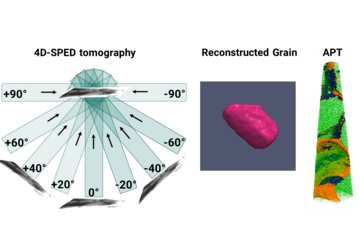All genres
1.
Journal Article
Shearing brittle intermetallics enhances cryogenic strength and ductility of steels. Science 384 (6699), pp. 1017 - 1022 (2024)
2.
Journal Article
Advancing strength and counteracting embrittlement by displacive transformation in heterogeneous high-entropy alloys containing sigma phase. Acta Materialia 246, 118717 (2023)
3.
Journal Article
Microstructural and hardness evolutions of a cold-rolled cobalt. Materials Science and Engineering A: Structural Materials Properties Microstructure and Processing 803, 140712 (2021)
4.
Journal Article
Oxidation behavior of low-cost CP–Ti powders for additive manufacturing via fluidization. Corrosion Science 178, 109080 (2021)
5.
Journal Article
Cyclic Plasticity of CoCrFeMnNi High-Entropy Alloy (HEA): A Molecular Dynamics Simulation. Archive of Applied Mechanics 13 (1), 2150006 (2021)
6.
Journal Article
Ultrastrong lightweight compositionally complex steels via dual-nanoprecipitation. Science Advances 6 (46), eaba9543 (2020)
7.
Journal Article
Formation mechanism of κ-carbides and deformation behavior in Si-alloyed FeMnAlC lightweight steels. Acta Materialia 198, pp. 258 - 270 (2020)
8.
Journal Article
Selective laser melting of CP–Ti to overcome the low cost and high performance trade-off. Additive Manufacturing 34, 101198 (2020)
9.
Journal Article
Crystal plasticity finite element analysis of gradient nanostructured TWIP steel. International Journal of Plasticity 130, 102703 (2020)
10.
Journal Article
Grain refinement process in a cold-rolled polycrystalline cobalt. Materials Characterization 164, 110360 (2020)
11.
Journal Article
Characterization of the microstructure and deformation substructure evolution in a hierarchal high-entropy alloy by correlative EBSD and ECCI. Intermetallics 121, 106788 (2020)
12.
Journal Article
The tension-compression asymmetry of martensite phase transformation in a metastable Fe40Co20Cr20Mn10Ni10 high-entropy alloy. Science China Materials 63 (9), pp. 1797 - 1807 (2020)
13.
Journal Article
Enhancement of strength and ductility by interfacial nano-decoration in carbon nanotube/aluminum matrix composites. Carbon 159, pp. 201 - 212 (2020)
14.
Journal Article
Nitrogen induced heterogeneous structures overcome strength-ductility trade-off in an additively manufactured high-entropy alloy. Applied Materials Today 18, 100498 (2020)
15.
Journal Article
An SEM-based approach to characterize the microstructural evolution in a gradient CoCrFeNiMo0.15 high-entropy alloy. Materials Characterization 161, 110169 (2020)
16.
Journal Article
On the mechanism of extraordinary strain hardening in an interstitial high-entropy alloy under cryogenic conditions. Journal of Alloys and Compounds 781, pp. 734 - 743 (2019)
17.
Journal Article
Eutectic/eutectoid multi-principle component alloys: A review. Materials Characterization 147, pp. 545 - 557 (2019)
18.
Journal Article
Preliminary creep testing of the alumina-forming austenitic stainless steel Fe-20Cr-30Ni-2Nb-5Al. Materials Science and Engineering A: Structural Materials Properties Microstructure and Processing 718, pp. 492 - 498 (2018)
19.
Talk
Recent progresses in the understanding of metastable high-entropy alloys. TMS 2019 Annual Meeting & Exhibition, San Antonio, TX, USA (2019)
20.
Talk
Metastable high-entropy alloys: design, structure and properties. 2nd International Conference on High-Entropy Materials (ICHEM 2018), Jeju, South Korea (2018)











